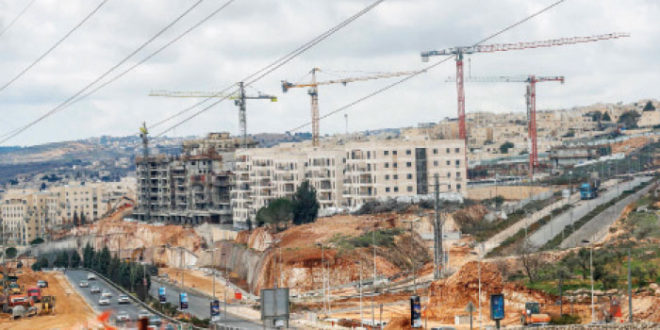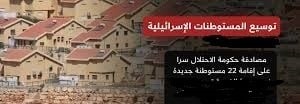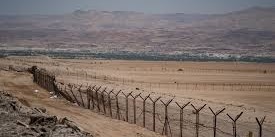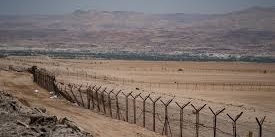By: Madeeha Al-A’raj
The National Bureau for defending land and resisting settlements ( nbprs ) stated in its latest weekly report , that settlement activities in the occupied West Bank continue, especially in the Jerusalem Governorate with the aim of separating the city from its Palestinian surroundings, changing the historical, legal and demographic reality of the occupied city, and removing it from any future negotiations as the capital of the State of Palestine, and preventing any possibility of contemplating the survival of the international airport that was known as Jerusalem Airport, worth mentioning that the airport was established in 1920, during the British Mandate, on an area of 650 donums.
Moreover, the Israeli occupation government has given its initial approval for a plan to build a settlement neighborhood that includes thousands of new settlement units on the lands of Qalandia Airport north of the occupied Jerusalem. The settlement plan includes the construction of about 11,000 settlement units, hotels, facilities, public parks, and industrial areas built on 1,243 donums north of Jerusalem, in addition to other commercial and tourism facilities.
The implementation of such a settlement plan that is the largest in decades would completely separate East Jerusalem from the north and from Ramallah city. In the first part of the plan, about 3800 housing units will be approved, and after environmental checks, it will be expanded to about 10,000 housing units, with commercial and employment areas in that area. The plan was approved by the local Planning and Building Committee before the final approval of the Regional Committee on Dec. 6th. The Israeli occupation municipality said that there is a large reserve of land available in the city, which allows development away from the open areas of high value, and the promotion of the plan provides an important solution to the city’s residential needs.
On the other hand, mayor of the occupied Jerusalem, Moshe Leon, announced the approval of the establishment of 2,000 settlement units in the “French Hill settlement” that was built on the lands of Mount Scopus in East Jerusalem. On his Facebook account, Leon said: “A new neighborhood will be built here.
As part of an agreement we signed between the Israel Land Administration and the Hebrew University, construction will be allowed on land that was owned by the university on French Hill and about 2,000 new housing units will be built on it near the train axis. For its part, the Hebrew University said that an agreement was signed between the Israel Land Authority and the university, the essence of which is the transfer of land to the state for residential and commercial marketing in the city of Jerusalem.
Under the agreement, the lands owned by the university will be transferred to the state, which constitute potential planning areas on Mount Scopus and Givat Ram, with a total area of about 150 donums, and the authority will work to promote planning and development in the region and its marketing for residential, rental and commercial projects, and employment.
Within the context, heads of missions of the European Union and other countries visited last week Palestinian areas in the vicinity of the city of Jerusalem, which are included in Israeli settlement plans, including the approved plan, which included the areas “E1” and Qalandia east and north of East Jerusalem. The visit came in the wake of recent statements by the Israeli occupation authorities on the development of major settlement plans in these areas.
During the visit, the Israeli NGO, Ir Amim, briefed the diplomats on the “very worrying consequences of the settlement plans in Givat Hamatos, Jabal Abu Ghneim, E1 and Qalandia,” and the repercussions they bear to displace Bedouin communities, and moves towards the actual annexation of Palestinian lands in the Jerusalem area and further fragmentation of Palestinian territories in the West Bank, as the heads of mission emphasized that the European Union and like-minded states would not recognize any changes to the pre-1967 borders, including with respect to Jerusalem, other than those agreed by the parties and that the settlements aim to Changing the identity of Jerusalem constitutes a violation of Israel’s obligations as an occupying power.
While 26 members of the US Congress from the Democratic Party called on Secretary of State Anthony Blinken to work to pressure the Israeli government to prevent settlement construction in the area classified as “E1” after the occupation government approved the construction of more than 3,000 settlement units in the area. They expressed their grave concern over Israeli decisions and plans to build more settlement units, undermining the so-called two-state solution in clear violation of international law.
As for forging facts and history, the Israeli Ministries of Religions, Antiquities and Tourism revealed a project that is being worked on to discover many of the old channels that supplied the city of Jerusalem with water in the Jebusite and Canaanite eras, linking this to the destruction of the alleged temple, the Babylonian captivity and the transformation of the southern channel in addition to a section of “Solomon’s Pools,” and the German tunnel to a tourist site, where an archaeological site was revealed in which there is a system of 25 columns ‘of about 80 holes’ carved out of the rock and part of them immersed in mud, which are water channels and huge water basins carved out of the rock, some of which are elaborately built.
The tunnels are linked to three pools that delivered water to Jerusalem and Bethlehem for many years. In 2000, a 150-meter-long section of the spring was prepared, and work is still going on. According to the Council of Settlement Communities, settlers and archaeologists who support the official Israeli narrative – which has been adopted by rabbis and politicians – descend and walk in the narrow cave with a protective cover and a flashlight installed on their heads to light the way in a beautiful water tunnel with dim lights and the sound of streams in the area of Gush Etzion, near the settlement of Efrat to the south of “Solomon’s Pools”, there is a 5-kilometre-long tunnel, which has an amazing design.
List of Israeli Assaults over the Last Week Documented by the National Bureau:
Jerusalem:
- Calling the Israeli settlers to storm the Al-Aqsa Mosque on the occasion of the so-called Hanukkah festival.
- Demolishing 2 agricultural barns with an area of 50 m2 for each in the Sawahrah area.
- Notifying citizen of the demolition of his house in the Al-Bustan Street in the Silwan town.
- Demolishing a three-storey house in the Wadi Al-Hummus area in the Sur Baher town, and residential buildings there, under the pretext of being near the apartheid wall.
Hebron:
- Attacking citizens’ vehicles with stones on the bypass road No. 60 near the areas of Al-Baqa’a, Al-Bouira, and Beit Anoun Junction, and smashing windows of a number of them, causes severe damage to them.
- Demolishing a house in the Khirbet Ma’in and notifying to demolish two other houses, one of which is located in the Khirbet Al Markaz, and another located in the Khirbet Al-Fakhit.
Ramallah:
- Attacking the vehicle of Nizar Abdel Hamid Rajabeh, near the Shilo settlement’s Junction, on the road between Nablus and Ramallah, near the Turmusaya town.
- Wounding child, Zain Khamis Farraj ,15, in the head, and 3 others while attacking Palestinian vehicle near the of Al-Mughayir village.
Nablus:
- Bulldozing agricultural lands near the Sabih Mount in the town of Beita, which is witnessing popular resistance activities since last May, in refusal to establish a settlement outpost on it, in addition to closing agricultural roads leading to the mountain with earth mounds.
- Closing the main entrances to the eastern Al-Lubban village, in addition to closing the northern entrance, and preventing citizens from entering or leaving it.
- Opening fire towards the citizen’s homes, and attacking vehicles with stones, near the entrance to Burqa village, northwest of Nablus.
Salfit:
- Handing a citizen from Bruqin a notice to vacate his cultivated land with an area of 21 dunums in the Khirbet Qarqash area, adjacent to the Ariel Industrial Zone, in addition to placing an eviction notice on the land, under the pretext of being in area C.
- Seizing a bulldozer belonging to Khaled Khair, while he was in the Deir Ballut Plain area.
Qalqilya:
- Bulldozing an agricultural land in the village of Al-Nabi Elias, with an area of 200 dunams.
- Seizing a concrete pump in the Jayous town, and another pump in Qalqilya.
Jordan Valley:
- Seizing an agricultural tractor working on agricultural land near the settlements of “Ro’eya” and “Bekoot” that are built on citizens’ lands in the northern Jordan Valley.
- Notifying to stop work on a water tank in Atouf, for the agricultural use, with a capacity of 1,000 cups.
 المكتب الوطني للدفاع عن الارض ومقاومة الاستيطان منظمة التحرير الفلسطينية
المكتب الوطني للدفاع عن الارض ومقاومة الاستيطان منظمة التحرير الفلسطينية




